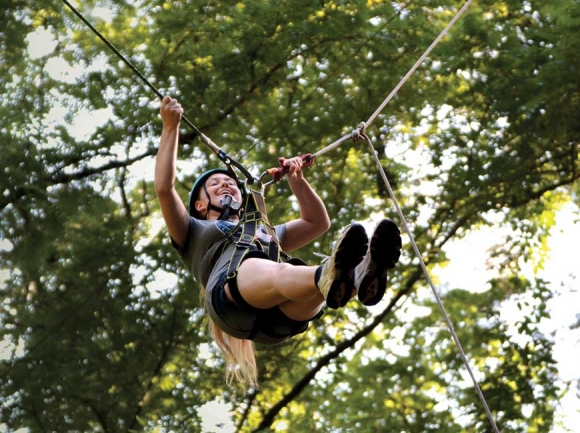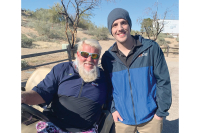Outdoors 2018: The year in quotes
 SEE Adventure Camp attracts blind teens from across the country for a week of zip-lining, hiking and whitewater rafting.
SEE Adventure Camp attracts blind teens from across the country for a week of zip-lining, hiking and whitewater rafting.
From the depths of winter to the height of summer, valley agriculture to mountain exploration, longtime mountain dwellers to new arrivals, a year in Western North Carolina’s great outdoors can provide a lifetime of stories. In 2018, The Smoky Mountain News covered everything from conservation to kudzu, encountering plenty of colorful characters along the way. Here’s a selection of the best quotes we heard this year, about the mountains and from those who love them.
January
“More land doesn’t keep appearing. It just keeps disappearing. Its use is really important because down the road you want your kids and grandkids to be able to walk out and take a hike, go for 4 miles and not see any people or houses or phone lines or anything like that, to wander across a bear or something that’s wild and living.”
— Karen Collis, Maggie Valley resident
Had Collis’ family not believed this statement so strongly, the land now called the William H. Silver Game Land would have been passed down to Collis and her children and her children’s children in increasingly fragmented pieces. But Collis’ father Robert Williams sold his 783 acres of pristine land to The Conservation Fund for roughly half its market value, with more landowners following suit. Today, the 1,925-acre property is owned by the N.C. Wildlife Resources Commission and offers opportunity for wildlife, hikers and hunters.
February
“A seed bank is a never-ending thing. You never get caught up. There’s always more species.”
— Joe-Ann McCoy, research director at the N.C. Arboretum
Related Items
McCoy has spent the past 10 years working to build a seed bank preserving the scope and diversity of plant life in Western North Carolina, with seed from about 2,000 plants currently in storage. The hope is that if a species goes extinct or becomes so rare that its genetic diversity is threatened, the seed bank will allow it to be resurrected.

March
“I look at that hill of kudzu, and instead of seeing a problem, I see this huge bank full of food and medicine. It’s a felt sense of that. It’s like looking out and seeing a field full of peaches or a field full of corn, or cows. It’s a transformation of consciousness and relationship to the plant.”
— Zev Friedman, permaculture designer and kudzu harvester
Kudzu is infamous in the South for its colonization of fields and roadways, the seemingly infinite vines growing up to a foot per day in the summertime. But Zev and his fellow kudzu enthusiast Justin Holt believe that kudzu is misunderstood. It’s not as aggressive an invasive as it’s been portrayed, and is actually quite useful, a resource for animal fodder, starch, medicine, basketry, papermaking and more. Holt and Friedman have thrown themselves into spreading the word about kudzu, even hosting a “kudzu camp” in Dillsboro to offer hands-on instruction in harvesting and processing the plant.
April
“That’s why the outdoors is such a good metaphor. It’s exactly like setting a line or paddling a rapid. You try to plan your line before you go, but things might happen, and you have to adapt, overcome.”
— Peter Moyle, Gnarcissist Gear co-owner
Moyle and his business partner Nick Provost were fresh college graduates when they started Gnarcissist, which makes polarized sunglasses designed to be affordable enough to replace but durable enough to withstand some abuse. The business’s success is the result of good planning, but also of thinking on their feet — a formula that holds true for mountain exploration as well as for career success.

May
“They have that notorious reputation of being stubborn, but they’re not really stubborn — they just don’t want to get hurt. It’s self-preservation. If it doesn’t look safe, a horse will just walk over it, but a mule’s like, ‘Eh, I don’t know about that.’ They are thinkers.”
— Danny Gibson, animal packer for the Great Smoky Mountains National Park
Gibson has been working with the park’s mule team for more than 10 years, and while mules get a bad rap as stubborn and ornery, Gibson knows the truth — without them, many trail maintenance projects would be just about impossible to complete. A mule can walk for miles hauling 250 pounds, with a team of mules capable of moving even the largest logs. Between 2009 and 2016, horses and mules have carried an estimated 252,850 pounds over 2,615 miles of trail, also pulling 11 footlogs weighing as much as 4,500 pounds apiece and participating in five search and rescues.
June
“Every year I had satisfaction in the challenges I went through. The hardships, whatever it was. I always survived and made it.”
— Bill Holbrook, owner of Cold Mountain Farms
Holbrook is a farmer at heart and by trade, having assembled his 175-acre farm from an initial purchase of just 11 acres. It’s storied ground for him, bearing the memory of its original Cherokee inhabitants and of his own ancestors. Holbrook’s commitment to the land and community has earned him numerous awards over the years, most recently a May induction into the Western North Carolina Agricultural Hall of Fame.
July
“Education has always been a calling for me. And I wanted to do the educational work that I really enjoyed myself. Most of the courses we offer are courses I would want to take. Plus, it allows you to be around people who love nature, who really enjoy learning about the outdoors.”
— Brent Martin, co-owner of Alarka Institute
Martin, a longtime lover of nature and former regional director for The Wilderness Society, had been thinking for years about launching a venture like Alarka with his wife Angela before an unexpected job loss accelerated the timeline. Now in its second year, Alarka Institute offers outdoor adventures from mushroom foraging to canoe-based cultural tours, as well as classes in nature-based art and writing.
August
“Even if you stumble and fall and skin your knee, that’s OK with us. In fact, skinned knees should be a part of every childhood I think, and some of these kids don’t get that opportunity often enough, because sometimes they are overprotected.”
— Jay Hardwig, director of SEE Adventure Camp
Outdoor adventure has the power to build self-confidence and community, and IFB Solutions believes that blind and visually impaired kids should be afforded that benefit too. Now in its third year, IFB’s SEE Adventure Camp attracts blind teens from across the country for a week of zip-lining, hiking and whitewater rafting. The experience helps them see beyond the limits the world may try to impose on them and to build community with other teens dealing with visual impairment.
September
“I feel like it re-centers me as a person, as a spouse and as a mom. Every year reminds me of who I am, which I feel like in turn makes me better in those roles that I play.”
— Erin McManus, Sylva resident
McManus is an employee, a wife and a mother, but for the past 20 years she and her friend Amy Miller have made time for an annual rock-climbing trip. On the rocks, McManus finds a peace, a focus and a trust that has followed her through the decades and carries her through each year.
October
“When you’re restoring habitat, you’re restoring habitat for all. It’s an ecosystem. Everything is an ebb and a flow and a balance.”
— Jill Jacobs, co-owner of Spriggly’s Beescaping
Jacobs and her husband Brannen Basham launched Spriggly’s out of a love for native pollinators and a desire to educate others about how important they are. Landscaping with native plants of a diversity of color and blooming periods doesn’t just benefit pollinators — it boosts all manner of native species that depend on naturalized landscapes to thrive.

November
“Before we were managing the park for the ‘gift wrapping’ which is the stuff you can easily see — the birds, the trees, the flowers — but not focusing on what was inside of the box, which when you lift the lid, that’s all the little things, and the little things are what keeps the park running smoothly.”
— Susan Sachs, education branch chief for the Great Smoky Mountains National Park
An effort to catalogue every species in the park turned 20 this year, with the All Taxa Biodiversity Index having to date logged 19,866 species, of which 9,523 had never before been found in the park and 1,000 had never been found anywhere at all. By and large, the new discoveries are organisms that tend to get overlooked — lichens, beetles and flies, for instance — but in an ecosystem every species has a role. The more is known about those species and their roles, the better decisions park managers can make in their efforts to preserve the Smokies for future generations.
December
“Our culture is not linear. It’s more circular, and going back to places like the park, to where we once inhabited and lived and collected, it takes on a different meaning of spirituality. It takes on a different meaning of who we are as Cherokee.”
— Tommy Cabe, forest resource specialist for the Eastern Band of Cherokee Indians
Before Europeans arrived in the Southern Appalachians, the Cherokee people lived, hunted and gathered from a territory that covered portions of eight present-day states, including what is now the Great Smoky Mountains National Park. Park rules prohibit gathering plants, but a new proposal would allow Cherokee people to start gathering the spring green sochan within park boundaries. If all goes well, the tribe could secure similar agreements for other culturally important species.









